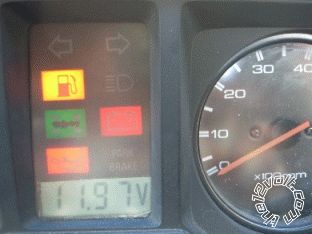I know what you mean.... even welded heads (ever had to remove a 4WD head with a hacksaw! (Aussie) Bore-water isn't good...)
I have a 1965 Isuzu ute (pickup) but have retrofitted ~1985-1990 Isuzu (Jackaroo/Trooper) gauges....
I got sick of imperial speedos (we went metric in 1072), and old-style bouncy electro-mag gauges - newer thermal are much better.
But with that came the sensors to match the dials, though I did like my inverse fuel gauge - perfect except empty was full & vice-versa.
But I finally changed the sender with a little effort (elongation of 5 screw holes and a lot of wiper-arm bending) with the bonus of a low-fuel warning lamp that comes on when I have 10% further remaining. I no longer carry a jerry can and know to within a few km when I'll run dry.
But with all gauges, I feel there is a need for the idiot light or annunciator....
You shouldn't have to monitor things - they should draw your attention to abnormalities.
Hence lamps etc - whether flashing dial lamps or separate - as common for oil pressure gauges where the oil-pressure dash lamp still exists.
The other aspect is my old favourite - redundancy.
F.ex - if my fuel gauges circuit fails, I have an electrically independent low fuel lamp.
Ditto for standard oil-pressure switches/lamps and oil-pressure sender/gauges.
Hence rather than
replace old standard gauges, why not
augment them?
EG - voltage sense circuits across its sensors for over-temp lights, or (better still) separate thermo switches etc.
(F.ex I have an electric fan. I intend to place $5 klixons (temp switch) here and there to ground switch the fan relay should their threshhold be exceeded - whether head, block, or radiator. This may be in addition to any adjustable switch from the temp gauge etc. Kilxons can also be mounted on differentials, gearboxes, transfer cases, axles, brakes etc for simple alarms.)
The problem is when wanting to add intelligence - ie, values to unmarked gauges.
That's where I think new & old.
Keep the old's cool charm... (the old standard gauges).
Add whatever new display - a 3" or 7" LCD, or small LCD that can flash up the alarmed parameter, or cycle through values upon interrogation....
Hence you still have the original "reliable" stuff. But with a modern backup.
That newskool display can have the automated alerts etc.
EG - I mounted an LCD voltmeter in my 1980s dash in my 1965 ute.
From this (a great voltmenter from ABR-Sidewinder)...

To this....

The only problem being that it isn't backlit. (I have since blanked off the last digit so only
11.9 shows.)
How do you get a suitable cheap backlit LCD display>
EASY - you buy a cute blue-lit meat cooking sensor for $15, or a backlit DMM for $11, or a $1 mobile phone; discard everything bar the display, and interface it to your own program... (probably in a PIC - like the Fusion Brain etc)
It's much easier with electronic dashes. EG - one day I may finally re-engineer the guts of the 1980s Isuzu Piazza (Impulse) so its display reports a plethora of enhancements... At least the display is already there...
PS -
KP - my last replay missed yours.... My "No" was directed at the "off the shelf" comment...
 Printable version
Printable version
















 To this....
To this....
 The only problem being that it isn't backlit. (I have since blanked off the last digit so only 11.9 shows.)
How do you get a suitable cheap backlit LCD display>
EASY - you buy a cute blue-lit meat cooking sensor for $15, or a backlit DMM for $11, or a $1 mobile phone; discard everything bar the display, and interface it to your own program... (probably in a PIC - like the Fusion Brain etc)
It's much easier with electronic dashes. EG - one day I may finally re-engineer the guts of the 1980s Isuzu Piazza (Impulse) so its display reports a plethora of enhancements... At least the display is already there...
PS - KP - my last replay missed yours.... My "No" was directed at the "off the shelf" comment...
The only problem being that it isn't backlit. (I have since blanked off the last digit so only 11.9 shows.)
How do you get a suitable cheap backlit LCD display>
EASY - you buy a cute blue-lit meat cooking sensor for $15, or a backlit DMM for $11, or a $1 mobile phone; discard everything bar the display, and interface it to your own program... (probably in a PIC - like the Fusion Brain etc)
It's much easier with electronic dashes. EG - one day I may finally re-engineer the guts of the 1980s Isuzu Piazza (Impulse) so its display reports a plethora of enhancements... At least the display is already there...
PS - KP - my last replay missed yours.... My "No" was directed at the "off the shelf" comment...